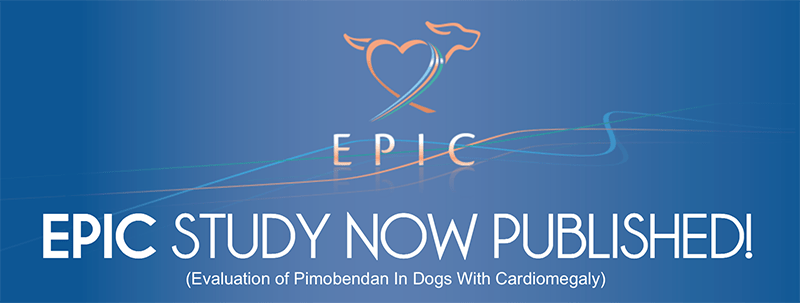Mitral Valve Disease Staging (Epic Trial)

What is EPIC?
EPIC stands for Evaluation of Pimobendan In dogs with Cardiomegaly. It is the largest veterinary clinical trial conducted to date, which took seven years to complete and involved 360 dogs from 11 different countries. We are proud to say that Dr. Mark Patteson was one of only three UK investigators on the trial, showing our ongoing commitment to research here at HeartVets.
EPIC was a prospective study which was double-blinded, placebo-controlled and randomised, therefore the results provide us with the best possible level of evidence to guide treatment of our clinical patients.
Small breed dogs (<15kg) greater than 6 years of age were recruited to the study based upon the presence of a moderate to high-intensity murmur as well as evidence of echocardiographic and radiographic cardiomegaly. The criteria used to determine this were:
Murmur grade 3/6 or louder
Vertebral heart sum (VHS) >10.5
LA:Ao ratio >1.6
LV internal diameter in diastole (normalized for body weight) > 1.7
The dogs were divided into two groups, one was treated with pimobendan (0.4-0.6mg/kg/day divided into two equal doses) and the other received a placebo. The results showed that treatment with pimobendan extended the asymptomatic period by approximately 15 months compared to placebo.
What does this mean?
These results show that in small breed dogs with a moderate or loud systolic heart murmur, further investigation should be undertaken to confirm presence of degenerative mitral valve disease, and establish the stage of disease. Dogs fulfilling the criteria described above would be described as “advanced preclinical” (or class B2 on the ACVIM classification scheme) and are very likely to benefit from treatment with pimobendan.
If you are treating a small breed dog with a moderate-to-loud systolic heart murmur and radiographic cardiomegaly, and have performed an echocardiogram, you can use our calculator to determine whether your patient would benefit from pimobendan based upon these results:
This calculator is being updated as of 14/10/24 and is not yet finalised or ready for use.
Lateral thoracic radiograph showing marked cardiomegaly, with severe left atrial enlaragement (single arrow) and congestion of cranial pulmonary lobar vessels (double arrow).
The white arrows over the cardiac silhouette show ideal positioning for calculating the vertebral heart sum, VHS.
Echo images of the right parasternal short axis view at the level of the chordae tendinae – used to create the M-mode image for measurement of the LV internal diameter in systole and diastole.
Below: right parasternal short axis view showing measurement of the aorta and left atrium.
